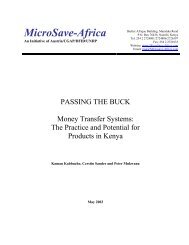Create successful ePaper yourself
Turn your PDF publications into a flip-book with our unique Google optimized e-Paper software.
As USAID moved<br />
away from large, longterm<br />
projects, <strong>DAI</strong> bid<br />
on a host <strong>of</strong> smaller,<br />
rural development<br />
projects in Egypt and<br />
elsewhere.<br />
26<br />
described as “creative opportunism,” was<br />
perhaps unavoidable in the early 1980s as <strong>DAI</strong><br />
scrambled to piece together from many smaller<br />
projects the revenue formerly achieved in a<br />
few big ones. But it meant that <strong>DAI</strong>’s business<br />
model was reverting to the one that had proven<br />
unsustainable, for practical reasons, when the<br />
original team chased billable days and spent<br />
many months on the road.<br />
At the same time, <strong>DAI</strong>’s back <strong>of</strong>fice struggled<br />
to keep up with the ever-growing number <strong>of</strong><br />
contracts. Mickelwait’s working agreement with<br />
Barclay was that he would handle strategy and<br />
new business if Barclay would focus on day-today<br />
operations and coordination <strong>of</strong> the billable<br />
assignments and travel <strong>of</strong> home <strong>of</strong>fice staff, a<br />
relationship soon dubbed the “Don and Tony<br />
Show.” Mickelwait, as David Gunning put it,<br />
was “the dreamer, the guy with the great ideas,<br />
many <strong>of</strong> which were not marketable.” Barclay<br />
Photo by Theresa Miles, <strong>DAI</strong><br />
“brought this business sense and judgment to<br />
the game.” There was also a homier appellation<br />
for the two: “Mom and Dad.” As one veteran put<br />
it, “Certain things you took to Dad and certain<br />
things you took to Mom.”<br />
With Mickelwait charging a host <strong>of</strong> hills and<br />
Barclay laboring to create order at headquarters,<br />
<strong>DAI</strong> was working harder than ever before.<br />
Unfortunately, the revenues did not reflect it.<br />
The view from the plateau was dispiriting: from<br />
1981 to 1983, revenues remained in the $6<br />
million to $7 million range. And as competition<br />
grew ever tougher in the USAID marketplace,<br />
<strong>DAI</strong> struggled to control its overhead costs<br />
while maintaining quality, staff morale, and the<br />
technical edge that had built its reputation. The<br />
challenge was not just that <strong>DAI</strong> was managing<br />
a large portfolio <strong>of</strong> short-term contracts, some<br />
well under $100,000. To backstop the large multiyear<br />
implementation contracts such as North<br />
Shaba and PDP, <strong>DAI</strong> had chosen to hire and<br />
retain a cadre <strong>of</strong> senior technical staff—this had<br />
been the rationale for hiring Barclay and others<br />
with similar backgrounds and skills. But relative<br />
to many competitors, this made <strong>DAI</strong> a high-cost<br />
service provider, and it was far from clear that<br />
the market would value in-house expertise and<br />
its associated costs in the same way that <strong>DAI</strong><br />
itself did.<br />
The poor results in 1981 and lack <strong>of</strong> growth in<br />
1982 and 1983 kept margins extremely thin.<br />
<strong>DAI</strong> raised some new capital through annual<br />
stock <strong>of</strong>ferings to employees, and, when things<br />
got very tight, obtained temporary loans from



